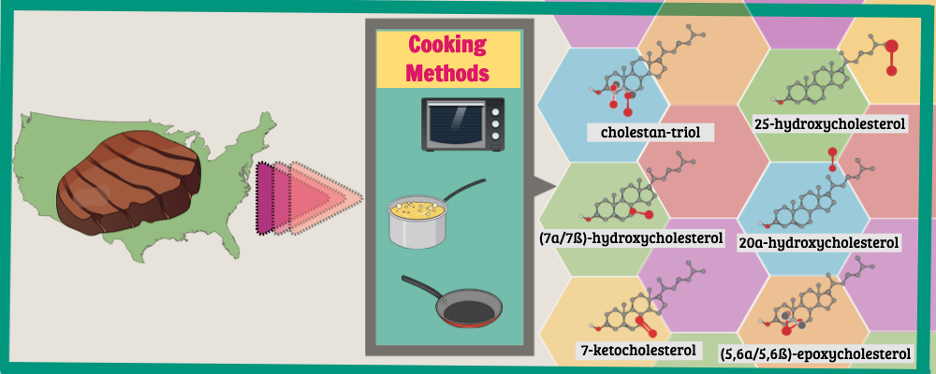2020 Virtual AIChE Annual Meeting
(160e) Nutritional Safety of the Oxidized Compounds of Ultra-Processed Foods in the Western Diet
Authors
RTE fat values were similar to those described in the itemâs nutritional fact label. Forty six percent of the RTE items (17 out of 39 RTE items) showed a higher value compared to the value shown in the nutritional label. For the FF group, a 74% of the FF meals showed a higher lipid content (for 17 FF meals out of 23 compared to the fat value) compared to what the nutritional information stablished. Overall, SFAs was the group with the highest percentages within the RTE, followed by MUFAs, and lastly, PUFAs. MUFAs was the group with the highest percentages within the FF meals, followed by SFAs, and lastly, PUFAs. For the TBARS assay, RTE items showed a higher MDA content compared to FF meals as it can be observed from the MDA values. However, more FF meals showed âno-presenceâ of MDA, potentially meaning the conversion of MDA molecules into further oxidation products.
Six phytosterols (Campesterol, Stigmasterol, Brassicasterol, b-Sitosterol, Fucosterol, and b-Tocopherol) were quantified for FF meals and RTE items. b-Sitosterol was the the phytosterol with the highest quantities within the FF meals, and b-Sitosterol was the the phytosterol with the highest quantities within the RTE items. Sixteen FF meals out of 23 showed a higher cholesterol content compared to the value found in either the USDA webpage, the FFâs nutritional webpages, or other Food Nutrition webpages used for this analysis (Eat this much (DeMenthon, n.d.) and Fast Food Nutrition (Lenhoff, 2005)). Two items (KFCâs mashed potato and McDonaldâs hotcakes) showed cholesterol values of 90.13 and 268.72 mg/100 g fat, respectively; even when their cholesterol content in each official FF webpage stablished that these items have 0 mg/100 g fat.
Nine RTE items out of 39 showed a higher cholesterol content compared to the value found in the itemâs nutrition fact label (598.42 ± 126.63 mg/100 g fat â Oscar Mayerâs salami, 102.60 ± 18.68 mg/100 g fat â Hellmannâs mayonnaise, 276.81 ± 1.83 mg/100 g fat â Praire Farmsâs butter, 307.81 ± 3.54 mg/100 g fat â Campbellâs beans and bacon soup, 300.53 ± 20.51 mg/100 g fat â Meijerâs macaroni salad, 2,135.58 ± 168.32 mg/100 g fat â Krogerâs chicken noodle soup, 1,247 ± 227.45 mg/100 g fat â Beech Nutâs beef and broth baby food, and 313.34 ± 27.54 mg/100 g fat â Gerberâs turkey and vegetables. Gerberâs strawberry-banana yogurt showed a cholesterol content of 316.80 ± 0.40 mg/100 g fat when the USDA food database said there was 0 mg/100 g fat.
Eight different COPs (7a-OH, 7b-OH, 5,6a-Epoxy, 5,6b-Epoxy, triol, 7-Keto, and 24 methylenecholesterol, and 6-Keto) were determined in FF meals and RTE items by GC-MS operated in SIM mode. In FF meals, total COPs content reached values up to 10.81 ± 1.52 mg/100g fat (roast beef, ham & provolone sandwich â Panda Express). On the contrary, the lowest amount was 0.28 ± 0.059 mg/100g fat (Dominoâs Pizza â Pepperoni pizza). For RTE items, the highest value for total COPs was Beech Nutâs turkey and broth baby food with 14.41 ± 4.37 mg/100 g fat. The lowest COPs contents were: 0 mg/ 100 g fat for both RTE items, Countryside Creamery margarine, and Purple Cow vanilla ice cream.
Cholesterol oxidation by different cooking processes and addition of spices and ingredients was followed by both TBARS and FAME quantifications COPs concentrations were positively associated with cholesterol concentration. However, the association was (correlation = 0.504), indicating that food matrix and food processing play a role in the formation of COPs. Results showed that different processing conditions of UP foods result in the formation of high amount of COPs and other oxidized derivatives such as phytosterols oxidation products (POPs), which were also identified in our samples. UP foods are produced under different and variable conditions. Therefore, an expansion of this data base is vital to know their occurrence in the Western Diet, together with a dietary exposure analysis of these compounds, ensuring food quanlity and humanâs food safety.
References:
- Juul, F., et al., Ultra-processed food consumption and excess weight among US adults. British Journal of Nutrition, 2018. 120(1): p. 90-100.
- Setyowati, D., N. Andarwulan, and P.E. Giriwono, Processed and ultraprocessed food consumption pattern in the Jakarta Individual Food Consumption Survey 2014. Asia Pacific Journal of Clinical Nutrition, 2018. 27(4): p. 840-847.
- Hintze, K.J., A.D. Benninghoff, and R.E. Ward, Formulation of the Total Western Diet (TWD) as a Basal Diet for Rodent Cancer Studies. Journal of Agricultural and Food Chemistry, 2012. 60(27): p. 6736-6742.
- Maldonado-Pereira, L., et al., The role of cholesterol oxidation products in food toxicity. Food and Chemical Toxicology, 2018.

